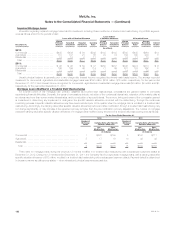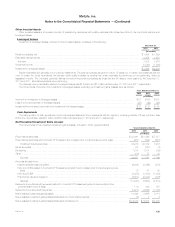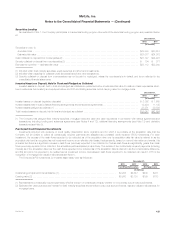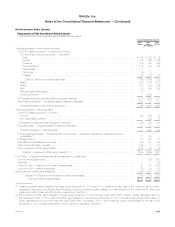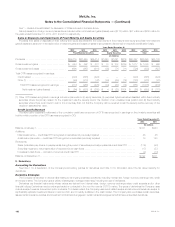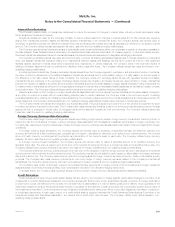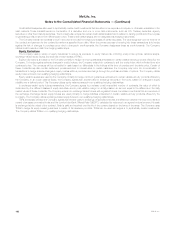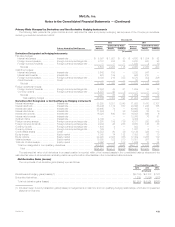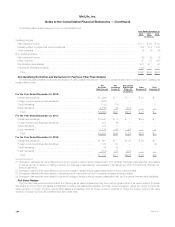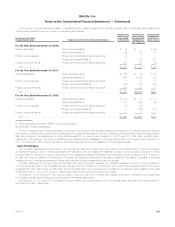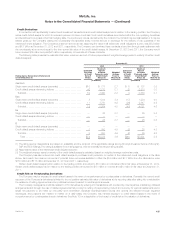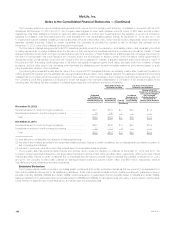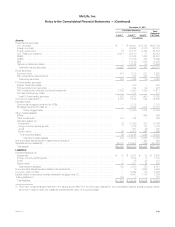MetLife 2012 Annual Report Download - page 137
Download and view the complete annual report
Please find page 137 of the 2012 MetLife annual report below. You can navigate through the pages in the report by either clicking on the pages listed below, or by using the keyword search tool below to find specific information within the annual report.
MetLife, Inc.
Notes to the Consolidated Financial Statements — (Continued)
Interest Rate Derivatives
The Company uses a variety of interest rate derivatives to reduce its exposure to changes in interest rates, including interest rate swaps, caps,
floors, swaptions, futures and forwards.
Interest rate swaps are used by the Company primarily to reduce market risks from changes in interest rates and to alter interest rate exposure
arising from mismatches between assets and liabilities (duration mismatches). In an interest rate swap, the Company agrees with another party to
exchange, at specified intervals, the difference between fixed rate and floating rate interest amounts as calculated by reference to an agreed notional
amount. The Company utilizes interest rate swaps in fair value, cash flow and non-qualifying hedging relationships.
The Company uses structured interest rate swaps to synthetically create investments that are either more expensive to acquire or otherwise unavailable in
the cash markets. These transactions are a combination of a derivative and a cash instrument such as a U.S. Treasury, agency, or other fixed maturity security.
Structured interest rate swaps are included in interest rate swaps. Structured interest rate swaps are not designated as hedging instruments
The Company purchases interest rate caps and floors primarily to protect its floating rate liabilities against rises in interest rates above a specified
level, and against interest rate exposure arising from mismatches between assets and liabilities, as well as to protect its minimum rate guarantee
liabilities against declines in interest rates below a specified level, respectively. In certain instances, the Company locks in the economic impactof
existing purchased caps and floors by entering into offsetting written caps and floors. The Company utilizes interest rate caps and floors in non-
qualifying hedging relationships.
In exchange-traded interest rate (Treasury and swap) futures transactions, the Company agrees to purchase or sell a specified number of contracts,
the value of which is determined by the different classes of interest rate securities, and to post variation margin on a daily basis in an amount equal to
the difference in the daily market values of those contracts. The Company enters into exchange-traded futures with regulated futures commission
merchants that are members of the exchange. Exchange-traded interest rate (Treasury and swap) futures are used primarily to hedge mismatches
between the duration of assets in a portfolio and the duration of liabilities supported by those assets, to hedge against changes in value of securities the
Company owns or anticipates acquiring and to hedge against changes in interest rates on anticipated liability issuances by replicating Treasury or swap
curve performance. The Company utilizes exchange-traded interest rate futures in non-qualifying hedging relationships.
Swaptions are used by the Company to hedge interest rate risk associated with the Company’s long-term liabilities and invested assets. A swaption
is an option to enter into a swap with a forward starting effective date. In certain instances, the Company locks in the economic impact of existing
purchased swaptions by entering into offsetting written swaptions. The Company pays a premium for purchased swaptions and receives a premium for
written swaptions. The Company utilizes swaptions in non-qualifying hedging relationships. Swaptions are included in interest rate options.
The Company enters into interest rate forwards to buy and sell securities. The price is agreed upon at the time of the contract and payment for such
a contract is made at a specified future date. The Company also uses interest rate forwards to sell to be announced securities as economic hedges
against the risk of changes in the fair value of mortgage loans held-for-sale and interest rate lock commitments. The Company utilizes interest rate
forwards in cash flow and non-qualifying hedging relationships.
Foreign Currency Exchange Rate Derivatives
The Company uses foreign currency exchange rate derivatives including foreign currency swaps, foreign currency forwards and currency options, to
reduce the risk from fluctuations in foreign currency exchange rates associated with its assets and liabilities denominated in foreign currencies. The
Company also uses foreign currency derivatives to hedge the foreign currency exchange rate risk associated with certain of its net investments in foreign
operations.
In a foreign currency swap transaction, the Company agrees with another party to exchange, at specified intervals, the difference between one
currency and another at a fixed exchange rate, generally set at inception, calculated by reference to an agreed upon notional amount. The notional
amount of each currency is exchanged at the inception and termination of the currency swap by each party. The Company utilizes foreign currency
swaps in fair value, cash flow and non-qualifying hedging relationships.
In a foreign currency forward transaction, the Company agrees with another party to deliver a specified amount of an identified currency at a
specified future date. The price is agreed upon at the time of the contract and payment for such a contract is made at the specified future date. The
Company utilizes foreign currency forwards in fair value, net investment in foreign operations and non-qualifying hedging relationships.
The Company enters into currency options that give it the right, but not the obligation, to sell the foreign currency amount in exchange for a functional
currency amount within a limited time at a contracted price. The contracts may also be net settled in cash, based on differentials in the foreign exchange
rate and the strike price. The Company uses currency options to hedge against the foreign currency exposure inherent in certain of its variable annuity
products. The Company also uses currency options as an economic hedge of foreign currency exposure related to the Company’s international
subsidiaries. The Company utilizes currency options in net investment in foreign operations and non-qualifying hedging relationships.
The Company uses certain of its foreign currency denominated funding agreements to hedge portions of its net investments in foreign operations
against adverse movements in exchange rates. Such contracts are included in non-derivative hedging instruments.
To a lesser extent, the Company uses exchange-traded currency futures to hedge currency mismatches between assets and liabilities.
Credit Derivatives
Credit derivatives primarily include credit default swaps that are used by the Company to hedge against credit-related changes in the value of its
investments. In a credit default swap transaction, the Company agrees with another party to pay, at specified intervals, a premium to hedge credit risk. If
a credit event occurs, as defined by the contract, the contract may be cash settled or it may be settled gross by the delivery of par quantities of the
referenced investment equal to the specified swap notional in exchange for the payment of cash amounts by the counterparty equal to the par value of
the investment surrendered. Credit events vary by type of issuer but typically include bankruptcy, failure to pay debt obligations, repudiation, moratorium,
or involuntary restructuring. In each case, payout on a credit default swap is triggered only after the Credit Derivatives Determinations Committee of the
International Swaps and Derivatives Association, Inc. deems that a credit event has occurred. The Company utilizes credit default swaps in non-
qualifying hedging relationships.
MetLife, Inc. 131



